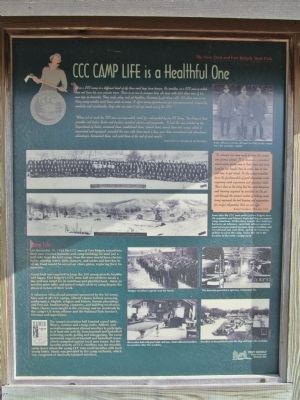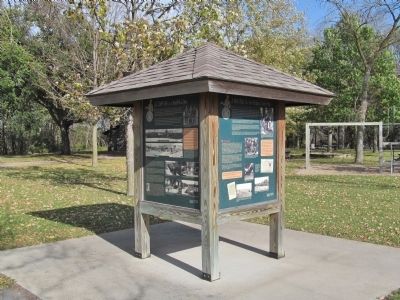Near Fairfax in Nicollet County, Minnesota — The American Midwest (Upper Plains)
CCC Camp Life is a Healthful One
The New Deal and Fort Ridgely State Park
— United States Civilian Conservation Corps —
"Life in a CCC camp is a different kind of life than most boys have known. An enrollee, as a CCC man is called, does not have his own private room. There is no one to pamper him. He lives with 200 other men of his own age, in barracks. They work, play, and eat together. Learning to get along with 199 other men is one thing every enrollee must learn while in camp. It offers many opportunities for self-improvement, physically, mentally and vocationally. Boys who can take it will get much out of the CCC."
"When not at work the CCC men are supervised, cared for, and guided by the US Army. The Army is their provider and tailor, doctor and teacher, spiritual adviser and paymaster. It took the men selected by the Department of Labor, examined them, conditioned them, clothed them, moved them into camps which it supervised and equipped, provided the men with three meals a day, gave them recreational and educational advantages, disciplined them, and paid them at the end of each month."
Your CCC-A Handbook for Enrollees
Camp Life
On November 10, 1934 the CCC men at Fort Ridgely moved into their new wooden barracks and camp buildings located just a half-mile from the tent camp. Now the men would have electric lights, running water, daily showers, and tables and benches to sit on. Food would be served on china plates, replacing their tin mess kits.
Good food was required to keep the 200 young men fit, healthy and happy. Fort Ridgely's CCC mess hall served three meals a day and was noted for its nutritious and plentiful food. Many an enrollee grew taller and gained weight while in camp despite the physical nature of their work.
A voluntary educational program sponsored by the US Army, here and at all CCC camps, offered classes in land surveying, mathematics, English, religion and history, human physiology and first aid, bookkeeping, carpentry, and building mechanics. These classes were taught in the evenings and on weekends by the camp's US Army officers and the National Park Service's foremen and supervisors.
The camp's recreation hall boasted a pool table, library, canteen and a large radio. Athletic and recreation equipment allowed enrollees to participate in at least one activity, from baseball and basketball to boxing, cards, golfing and tobogganing. The camp sponsored organized baseball and basketball teams, which competed against local area teams. But the favorite activity of CCC enrollees was the monthly camp dance where the young CCC men could
socialize with local young ladies. Music was provided by the camp orchestra, which was composed of musically-talented enrollees.
"No attempt has been made to turn the camps into formal schools. It is, however, a practical school where young men in their teens and early twenties are taught how to work, how to live and how to get ahead. In the camps enrollees learn the fundamentals of good citizenship while acquiring work experience and practical skills. This is done in the belief that the work discipline and training acquired by enrollees on the job and through the normal routine of orderly camp living represents the best training and preparation for useful citizenship that we can offer."
Robert Frechner, Director, CCC
Soon after the CCC men arrive at Fort Ridgely over 50 carpenters and laborers begin building permanent camp structures. Within three months they build ten barracks, an infirmary, mess hall, officers quarters, supervisory personnel quarters, shower building and recreational hall, tool sheds, and all the necessary utilities to serve the camp. Today this site is the location of the rustic campground.
State Park and
Historic Site
Topics and series. This historical marker is listed in these topic lists: Charity & Public Work • Parks & Recreational Areas. In addition, it is included in the Civilian Conservation Corps (CCC) series list. A significant historical month for this entry is November 1897.
Location. 44° 27.166′ N, 94° 43.89′ W. Marker is near Fairfax, Minnesota, in Nicollet County. Marker can be reached from County Highway 30, 0.7 miles west of State Highway 4, on the right when traveling west. Marker is northwest of the cemetery in Fort Ridgely State Park; fee area – a Minnesota state park vehicle permit is required. Touch for map. Marker is in this post office area: Fairfax MN 55332, United States of America. Touch for directions.
Other nearby markers. At least 8 other markers are within walking distance of this marker. Working Year-Round to Develop the Park (here, next to this marker); A New Deal for Fort Ridgely State Park (here, next to this marker); Fort Ridgely State Park's Buildings Today (here, next to this marker); Chief Mou-Zoo-Mau-Nee State Monument (about 400 feet away, measured in a direct line); Captain John S. Marsh State Monument (about 400 feet away); Eliza Müller State Monument (about 400 feet away); To the Memory of Hazen Mooers (about 400 feet away); Joseph LaFramboise - (about 500 feet away). Touch for a list and map of all markers in Fairfax.
More about this marker. photo captions:
• Army officers oversaw all aspects of life in the camps once the workday ended.
• Hungry enrollees eagerly wait for lunch.
• The barracks provided a Spartan, communal life.
• Recreation hall with pool table and easy chairs allowed enrollees to socialize after the workday.
• Enrollees in formation to raise the flag and begin the workday.
(photographs courtesy of the National Archives, Washington, D.C. or the Minnesota Department of Natural Resources)
Also see . . . Fort Ridgely State Park. Minnesota Department of Natural Resources. (Submitted on February 20, 2014.)
Credits. This page was last revised on December 15, 2020. It was originally submitted on February 20, 2014, by Keith L of Wisconsin Rapids, Wisconsin. This page has been viewed 452 times since then and 13 times this year. Photos: 1, 2. submitted on February 20, 2014, by Keith L of Wisconsin Rapids, Wisconsin.

